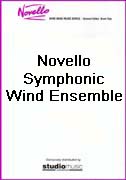Results
-
 £64.95
£64.95FIDDLER ON THE ROOF (Selection) (Army Journal) - Sharpe, Trevor Lee
Army Journal 862. A full listing of Chappell Army Journals is available - click the Chappell symbol on the home page. Printed to Order. Each set includes Conductor (Condensed Score); 2 x Solo B flat Clarinet; 2 x 1st B flat Cornet; 2 x Basses and 1 each of all other parts as originally published. We are unable to supply parts not included in the original sets.
Estimated dispatch 7-14 working days
-
 £64.95
£64.95GRENADIERS (Waldteufel)(Army Journal) - Waldteufel, Emile
Army Journal 743. A full listing of Chappell Army Journals is available - click the Chappell symbol on the home page. Printed to Order. Each set includes Conductor (Condensed Score); 2 x Solo B flat Clarinet; 2 x 1st B flat Cornet; 2 x Basses and 1 each of all other parts as originally published. We are unable to supply parts not included in the original sets.
Estimated dispatch 7-14 working days
-
 £64.95
£64.95HELTER SKELTER (Xylophone/Army Journal) - Lemon, W. G.
Army Journal 784. Xylophone & Wind Band. A full listing of Chappell Army Journals is available - click the Chappell symbol on the home page. Printed to Order. Each set includes Conductor (Condensed Score); 2 x Solo B flat Clarinet; 2 x 1st B flat Cornet; 2 x Basses and 1 each of all other parts as originally published. We are unable to supply parts not included in the original sets.
Estimated dispatch 7-14 working days
-
 £64.95
£64.95LONDON (Suite) (Army Journal) - Coates, Eric - Williams, Gerrard
Army Journal 607. Includes: Covent Garden; Westminster (Meditation); In Town Tonight (Knightsbridge March). A full listing of Chappell Army Journals is available - click the Chappell symbol on the home page. Printed to Order. Each set includes Conductor (Condensed Score); 2 x Solo B flat Clarinet; 2 x 1st B flat Cornet; 2 x Basses and 1 each of all other parts as originally published. We are unable to supply parts not included in the original sets.
Estimated dispatch 7-14 working days
-
 £64.95
£64.95LONDON LANDMARKS (Suite) (Army Journal) - Wood, Haydn - Duthoit, W. J.
Army Journal 729. Includes: Nelson's Column; Tower Hill; Horse Guards (Whitehall). A full listing of Chappell Army Journals is available - click the Chappell symbol on the home page. Printed to Order. Each set includes Conductor (Condensed Score); 2 x Solo B flat Clarinet; 2 x 1st B flat Cornet; 2 x Basses and 1 each of all other parts as originally published. We are unable to supply parts not included in the original sets.
Estimated dispatch 7-14 working days
-
 £137.95
£137.95MORNING MUSIC (Wind Ensemble) - Bennett, Richard Rodney
Score & Parts: Picc; 2 Fl; 2 Ob; Cor Ang; Eb Cl; 2 Cl; B.Cl; 2 Bsn; 2 A.Sax; Ten.Sax; Bar.Sax; 4 Hn' 3 Tpt; 2 Tbn; B.Tbn; Tuba; Timp; 3 Perc' Pno' Hp' Dbl.Bass.
Estimated dispatch 7-14 working days
-
 £64.95
£64.95NEWFOUNDLAND RHAPSODY (Army Journal) - Cable, Howard
A full listing of Chappell Army Journals is available - click the Chappell symbol on the home page. Printed to order. Each set includes Conductor (Condensed Score); 2 x Solo B flat Clarinet; 2 x 1st B flat Cornet; 2 x Basses and 1 each of all other part
Estimated dispatch 7-14 working days
-
 £64.95
£64.95PRELUDE TO PARSIFAL (Army Journal) - Wagner, Douglas E. - Godfrey, Dan
Army Journal 411. A full listing of Chappell Army Journals is available - click the Chappell symbol on the home page. Each set includes Conductor (Condensed Score); 2 x Solo B flat Clarinet; 2 x 1st B flat Cornet; 2 x Basses and 1 each of all other parts as originally published. We are unable to supply parts not included in the original sets.
Estimated dispatch 7-14 working days
-
 £64.95
£64.95QUEBEC FOLK FANTASY (Army Journal) - Cable, Howard - Duthoit, W. J.
Army Journal 799. A full listing of Chappell Army Journals is available - click the Chappell symbol on the home page. Printed to Order. Each set includes Conductor (Condensed Score); 2 x Solo B flat Clarinet; 2 x 1st B flat Cornet; 2 x Basses and 1 each of all other parts as originally published. We are unable to supply parts not included in the original sets.
Estimated dispatch 7-14 working days
-
 £64.95
£64.95TRUMPET CONCERTO (Haydn) (Trumpet/Army Journal) - Duthoit, W. J.
Army Journal 738. Trumpet & Wind Band. A full listing of Chappell Army Journals is available - click the Chappell symbol on the home page. Printed to Order. Each set includes Conductor (Condensed Score); 2 x Solo B flat Clarinet; 2 x 1st B flat Cornet; 2 x Basses and 1 each of all other parts as originally published. We are unable to supply parts not included in the original sets.
Estimated dispatch 7-14 working days
